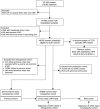Cervical HPV infection and neoplasia in a large population-based prospective study: the Manchester cohort
- PMID: 15292939
- PMCID: PMC2409880
- DOI: 10.1038/sj.bjc.6602049
Cervical HPV infection and neoplasia in a large population-based prospective study: the Manchester cohort
Abstract
Cytology and histology records and cervical samples for HPV assay were obtained from a prospective cohort of 49 655 women attending clinics for routine cervical cytology in or near Manchester between 1988 and 1993. The women were followed up for cytological abnormality and neoplasia through the cytology laboratory's records. HPV at entry was assayed in an age- and period-stratified random sample of 7278 women and in prevalent and incident CIN3 cases. The prevalence of newly diagnosed CIN3 increased with time since last normal smear, indicating that most cases persist for several years. CIN3 prevalence did not increase further for screening intervals exceeding 5 years, however, suggesting that CIN3 eventually regresses cytologically. CIN2 prevalence increased less steeply with screening interval, while the prevalence of lesser abnormality was almost independent of screening interval. The prevalence of oncogenic HPV at entry declined from 19% among women aged under 25 to less than 3% at age 40 or above. Oncogenic HPV infection was strongly predictive of subsequent CIN3 (OR 17.2, 95% CI 10.4-28.4), but only weakly related to CIN2 (OR 2.3, 95% CI 0.5-10.7) and lesser abnormality (OR 1.4, 95% CI 0.8-2.5). At current incidence rates, the lifetime risk of developing CIN3 will be 9% in this population. The cumulative risk of CIN3 diagnosis among cytologically normal women with oncogenic HPV detected at entry was 28% (CI 18-43%) after 14 years. Persistence of oncogenic HPV may be more sensitive and specific than cytology for early detection of CIN3 and invasive cancer.
Figures




References
-
- Arbyn M, Buntinx F, Van Ranst M, Paraskevaidis E, Martin-Hirsch P, Dillner J (2004) Virologic versus cytologic triage of women with equivocal Pap smears: a meta-analysis of the accuracy to detect high-grade intraepithelial neoplasia. J Natl Cancer Inst 96: 280–293 - PubMed
-
- Bauer H, Greer C, Manos M (1992) Determination of genital human papillomavirus infection by consensus PCR amplification. In Diagnostic Molecular Pathology: A Practical Approach, Herrington C, McGee J (eds) pp 131–152, Oxford: Oxford University Press
-
- Castle PE, Schiffman M, Gravitt PE, Kendall H, Fishman S, Dong H, Hildesheim A, Herrero R, Bratti MC, Sherman ME, Lorincz A, Schussler JE, Burk RD (2002) Comparisons of HPV DNA detection by MY09/11 PCR methods. J Med Virol 68: 417–423 - PubMed
-
- Cox JT, Schiffman M, Solomon D (2003) Prospective follow-up suggests similar risk of subsequent cervical intraepithelial neoplasia grade 2 or 3 among women with cervical intraepithelial neoplasia grade 1 or negative colposcopy and directed biopsy. Am J Obstet Gynecol 188: 1406–1412 - PubMed
-
- Cuzick J, Szarewski A, Cubie H, Hulman G, Kitchener H, Luesley D, McGoogan E, Menon U, Terry G, Edwards R, Brooks C, Desai M, Gie C, Ho L, Jacobs I, Pickles C, Sasieni P (2003) Management of women who test positive for high-risk types of human papillomavirus: the HART study. Lancet 362: 1871–1876 - PubMed

